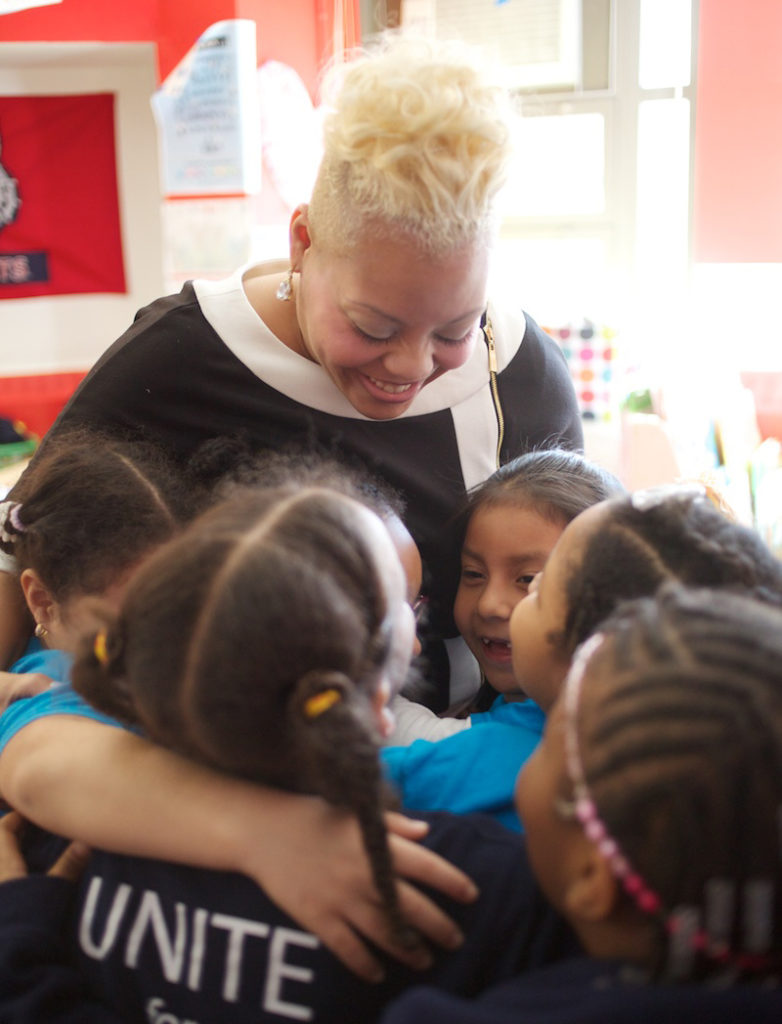Contents
KIPP Wheatley encourages teachers and leaders to learn more about how to become culturally relevant pedagogues. The following information may be useful in understanding–and sharing with students and families–the curriculum’s approach to culturally relevant pedagogy.
WHAT IS CULTURALLY RELEVANT PEDAGOGY?
In her 1995 article “Toward a Theory of Culturally Relevant Pedagogy,” Gloria Ladson-Billings builds upon research surrounding the intersectionality of culture and teaching to put forth a theoretical framework which she coined “culturally relevant pedagogy.” She highlights Jacqueline Jordan Irvine’s research on cultural synchronization (1990) and argues, “A next seep for positing effective pedagogical practice is a theoretical model that not only addresses student achievement but also helps students to accept and affirm their cultural identity while developing critical perspectives that challenge inequities that schools (and other institutions) perpetuate. I term this pedagogy, culturally relevant pedagogy.” (American Educational Research Journal, pg 469)

Ladson-Billings delves further into culturally relevant pedagogy in her book The Dreamkeepers, Successful Teachers of African American Children. The book profiles the pedagogy of eight seemingly varied teachers. She worked closely with these teachers, five of whom were African American and three of whom were Caucasian, for three years. From this work, she highlights and names the pedagogical practices, mindsets, and beliefs these eight women share. She describes these shared similarities as the components of a culturally relevant teacher. “Thus culturally relevant teaching uses student culture in order to maintain it and to transcend the negative effects of the dominant culture. The negative effects are brought about, for example, by not seeing one’s history, culture, or background represented in the textbook or curriculum or by seeing that history, culture or background distorted.” (The Dreamkeepers, pg 19)
Although there are various habits and actions that teachers who are culturally relevant exhibit, the framework is comprised of three essential components. Dr. Adrienne D. Dixson and Kenneth J. Fasching-Varner outline these three components their article “This Is How We Do It: Helping Teachers Understand Culturally Relevant Pedagogy in Diverse Classrooms.”
Three components of Culturally Relevant Pedagogy
- Academic Achievement includes but is not limited to objective measures of achievement. It is focused on teaching and learning rather than discipline. It assumes that children already know “stuff” and that it is the teachers’ job to scaffold their students’ knowledge.
- Sociopolitical Awareness presumes that knowledge is constructed and used toward the eradication of injustice. It understands that the role of the teacher and the learner is never neutral but situated socioculturally, sociohistorically, and sociopolitically.
- Cultural Competence suggests that teachers understand that they as well as their students are cultural beings. It appreciates and understands students’ cultures and uses them as the basis upon which the teaching and learning process is premised.
It should be noted that although we focus here on the work of Gloria Ladson-Billings, there are other pioneers of this great work. Through her research, Geneva Gay, author of Culturally Responsive Teaching: Theory, Research, and Practice coined the term “culturally responsive pedagogy.” Gay contends that a culturally responsive teacher “connects students’ cultural knowledge, prior experiences, and performance styles to academic knowledge and intellectual tools in ways that legitimize what students already know “ (“Culturally Responsive Teaching Matters,” by Elizabeth B. Kozleski). Jacqueline Jordan Irvine, author of Culturally Responsive Teaching: Lesson Planning for Elementary and Middle Grades, uses the terms “culturally relevant” and “culturally responsive” interchangeably. Although the terms may vary, the fundamental underpinnings of what make a culturally relevant teacher remain constant.
2018-2019 SUPPORT FOR CULTURALLY RELEVANT PEDAGOGY
In their book Culturally Responsive Teaching: Lesson Planning for Elementary and Middle Grades, Jacqueline Jordan Irvine and Beverly Jeanne Armento argue that “[i]n a culturally relevant approach to curriculum, students study about history, literature and the humanities through the eyes of different groups of people and are challenged to address the conflicting interpretations.” In the 2018-19 school year the KIPP Wheatley production team is leading a number of workstreams to improve KIPP Wheatley as a culturally relevant curriculum. This work builds on previous inclusivity and diversity work, expanding to support teachers and leaders in centering student identity and experience in ELA classrooms as a means of enhancing student learning. This work will grow over time and continue in close partnership with network feedback.
Updated curricular features:
- Text Summary and Classroom Library: A list of texts teachers can use for supplemental read alouds and independent reading. Includes analyses of the people and perspectives represented (and not represented) in module anchor texts.
- Foundational lessons: In partnership with the network, we are creating lessons to support teachers in developing background knowledge, increasing student engagement, and creating a social justice context for every module.
- Partnership with CRP expert: The KIPP Wheatley production team is partnering with Dr. Adrienne Dixson to provide professional development and ongoing feedback.

KIPP Wheatley remains committed to visibility of diverse cultures. We believe in:
- the importance of representation. At least three modules per grade explicitly include people of diverse racial, ethnic, and religious identities.
- highlighting issues of social justice. At least one module per grade explicitly explores social justice issues, beginning in grade 1.
- exploring alternative perspectives. Modules featuring a particular historical era or event will showcase a variety of perspectives, so that students can think critically about history and deepen their ability to understand multiple points of view.
CLASSROOM COMMUNITY
KIPP Wheatley instruction covers a variety of topics that students and classrooms will experience in different ways. While some content can be challenging to explore and facilitate respectful inquiry or discussion, it is one of the great powers of literature to provide space to reflect on difficult realities. Consider the ideas and guidance below as resources for supporting such reflection.
Plan and prepare:
- Plan with your coach how you will support grade- and module-specific content during module and lesson internalization.
- Alert parents and school leaders to prepare them for module content and to invite their guidance and input for an inclusive discussion.
Provide time for reflection. Students need to be able to share their own feelings and grapple with the issues raised. The curriculum provides embedded time for reflection.
- Lesson openers, CONNECT questions, and lesson closures are ideal for this on an ongoing basis. As needed, clarify that CONNECT questions help students make text-to-self connections and appreciate and enjoy reading and literary craft.
- Pause points and Socratic seminars provide opportunities for more extensive discussions.
- Journaling, freewriting, and other private writing forms, as well as unsigned more formal writing, all offer additional avenues of expression for students who are hesitant to share in class discussion.
Use and model respectful language, behavior, and discussion habits to create a classroom culture of inclusion.
- Invite students to help you develop classroom rules and habits for discussion, including that each of us is accountable for respectful behavior, we should respect all viewpoints, and that we can disagree respectfully. Never assume a student’s feelings. Provide opportunities for students to express themselves and model active listening.
- Be honest about your own feelings and explicitly introduce topics by sharing why you think it is important.
- Treat all students as individuals, not as representatives of any group with which they may or may not identify.
- Build class knowledge about issues, cultures, and social justice through readings, media, and by inviting school and community leaders or outside experts to share information and perspectives.
- Build personal and class knowledge of cultural expectations, rituals for courtesy, and symbols. For example, the common classroom student signal to show thumbs-up is deeply offensive in some cultures.
- Avoid making assumptions about students’ interest in, knowledge of, or comfort with cultural differences.
- Ask all students how to properly pronounce their names and facilitate practice by all. Invite students to identify their cultural or ethnic identity, rather than doing so for them on the basis of appearance, name, etc.
- Identify stereotypes in literature and popular culture that students may unconsciously incorporate into their thinking and/or language, such as that particular groups of people like to participate in particular activities or that everyone celebrates a particular holiday.
- Encourage students to share their cultural knowledge, including holidays, important words of greeting, and so on. Invite their expertise and leadership when reading literature that arises from or features cultures with which students are familiar, but don’t expect them to be representatives.
- As students’ capacity for nuance grows, introduce the idea that historical and current individuals and situations are often complex. For example, people who we admire deeply may sometimes behave in less admirable ways. Support students in reflecting on such complexity and further in exploring the role of 21st century media and technology in broadcasting behavior that was once unknown to a public person’s contemporaries.
- Speak privately in advance with individual students you think may be particularly concerned by a discussion to invite their input and explore their concerns.

LEARN MORE
- Teaching Tolerance: https://www.tolerance.org
- Being Culturally Responsive: https://www.tolerance.org/professional-development/being-culturally-responsive
- A New Set of Rules: https://www.tolerance.org/professional-development/a-new-set-of-rules
- Self-guided professional development for anti-bias education: https://www.tolerance.org/professional-development/self-guided-learning
- Teaching strategies from Facing History and Ourselves: https://www.facinghistory.org/resource-library/teaching-strategies
- Education Resources from Gender Spectrum: https://www.genderspectrum.org/resources/education-2/#more-424
- Ready, Set, RESPECT! GSLEN’s Elementary Toolkit: https://www.glsen.org/sites/default/files/GLSEN%20Ready%20Set%20Respect.pdf
- Queer Youth Advice for Educators: http://www.whatkidscando.org/publications/pdfs/QueerYouthAdvice.pdf
- Best Practices for Serving LGBTQ students: https://www.tolerance.org/magazine/publications/best-practices-for-serving-lgbtq-students
- Teaching the hard history of American slavery: https://www.splcenter.org/teaching-hard-history-american-slavery
- Resources from Shoah Foundation’s Institute for Visual History and Education: https://sfi.usc.edu/teach_and_learn
- Gestures to avoid in cross-cultural business: in other words, “Keep your fingers to yourself!”: https://www.huffingtonpost.com/gayle-cotton/cross-cultural-gestures_b_3437653.html
- 24 American customs that are considered offensive in other countries: http://www.businessinsider.com/american-behaviors-that-are-offensive-abroad-2015-8
Texts about Culturally Relevant Pedagogy
- The Dreamkeepers: Successful Teachers of African American Children by Gloria Ladson-Billings
- Culturally Responsive Teaching: Theory, Research and Practice by Geneva Gay
- Culturally Responsive Teaching: Lesson Planning for Elementary and Middle Grades by Jacqueline Irvine and Beverly Jeanne Armento
- “Toward a Theory of Culturally Relevant Pedagogy” by Gloria Ladson-Billings
- “Rethinking Pedagogy to Re-center Race: Some Reflections” by Caitlin L. Ryan and Adrienne D. Dixson
- “The Silenced Dialogue, Power and Pedagogy in Educating other people’s children” by Lisa Delpit
- “This is how we do it: Helping teachers understand culturally relevant pedagogy in diverse classrooms,” by Adrienne D. Dixson and Kenneth J. Fasching-Varner
- “Multiculturalism’s Five Dimensions” Dr. James A. Banks on Multicultural Education
- From Chapter 3: “Yes, but how do we do it?” by Gloria Ladson-Billings of White teachers/Diverse classrooms: Creating Inclusive Schools, Building on Students’ Diversity, and Providing True Educational Equity by Julie G. Landsman and Chance W Lewis
